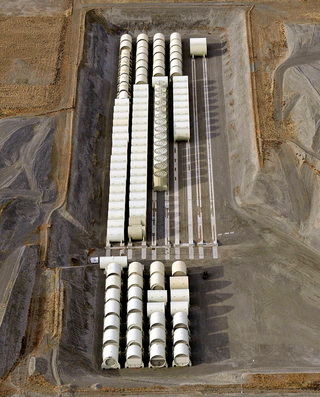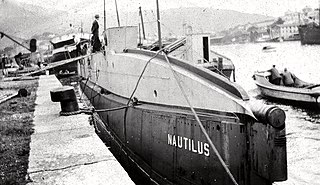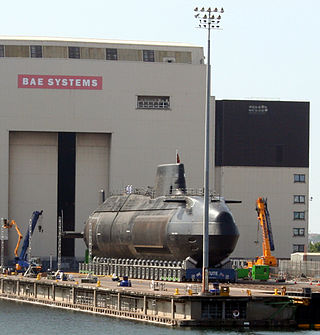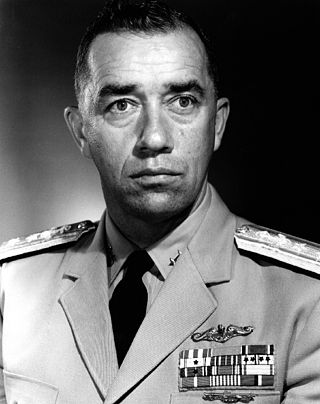Nautilus is the name of several submarines, submersibles, and semisubs. They are named for the nautilus.

A submarine is a watercraft capable of independent operation underwater. The term “submarine” is also sometimes used historically or informally to refer to remotely operated vehicles and robots, or to medium-sized or smaller vessels. Submarines are referred to as boats rather than ships regardless of their size.

United States naval reactors are nuclear reactors used by the United States Navy aboard certain ships to generate the steam used to produce power for propulsion, electric power, catapulting airplanes in aircraft carriers, and a few minor uses. Such naval nuclear reactors have a complete power plant associated with them. All commissioned U.S. Navy submarines and supercarriers built since 1975 are nuclear powered, with the last conventional carrier, USS Kitty Hawk, being decommissioned in May 2009. The U.S. Navy also had nine nuclear-powered cruisers with such reactors, but they have since been decommissioned also.

Naval Submarine Base New London is the primary United States Navy East Coast submarine base, also known as the "Home of the Submarine Force." It is located in Groton, Connecticut directly across the Thames River from its namesake city of New London.
USS Nautilus may refer to:

USS O-12 (SS-73) was an O-class submarine of the United States Navy. These later O-boats, O-11 through O-16, were designed by Lake Torpedo Boat to different specifications than the earlier Electric Boat designs. They performed poorly as compared to the Electric Boat units, and are sometimes considered a separate class. The ship was launched in 1917 and entered service with the Navy in 1918 in the Panama Canal Zone.

USS Skate (SSN-578) was the third submarine of the United States Navy named for the skate, a type of ray, was the lead ship of the Skate class of nuclear submarines. She was the third nuclear submarine commissioned, the first to make a completely submerged trans-Atlantic crossing, the second submarine to reach the North Pole, and the first to surface there.

An attack submarine or hunter-killer submarine is a submarine specifically designed for the purpose of attacking and sinking other submarines, surface combatants and merchant vessels. In the Soviet and Russian navies they were and are called "multi-purpose submarines". They are also used to protect friendly surface combatants and missile submarines. Some attack subs are also armed with cruise missiles, increasing the scope of their potential missions to include land targets.

USS Nautilus (SSN-571) was the world's first operational nuclear-powered submarine and on 3 August 1958 became the first submarine to complete a submerged transit of the North Pole. Her initial commanding officer was Eugene "Dennis" Wilkinson, a widely respected naval officer who set the stage for many of the protocols of today's Nuclear Navy of the US, and who had a storied career during military service and afterwards.

The V-boats were a group of nine United States Navy submarines built between World War I and World War II from 1921 to 1934 under authorization as the "fleet boat" program.

The submarine film is a subgenre of war film in which most of the plot revolves around a submarine below the ocean's surface. Films of this subgenre typically focus on a small but determined crew of submariners battling against enemy submarines or submarine-hunter ships, or against other problems ranging from disputes amongst the crew, threats of mutiny, life-threatening mechanical breakdowns, or the daily difficulties of living on a submarine.

A nuclear submarine is a submarine powered by a nuclear reactor, but not necessarily nuclear-armed. In the US classification, nuclear-powered submarines are designated as SSxN, where the SS denotes submarine, x=G means that the submarine is equipped with guided missiles, x=B means that the submarine is equipped with ballistic missiles and the N means that the submarine is nuclear-powered. SSN refers to nuclear-powered attack submarines, which do not carry missiles.

USS H-2 (SS-29) was a H-class submarine. She was originally named Nautilus, the third ship and first submarine of the United States Navy to bear the name, which was derived from a Greek word meaning "sailor" or "ship." The nautilus is also a tropical mollusk having a many-chambered, spiral shell with a pearly interior. It was also the name of the fictional submarine in Jules Verne's novel Twenty Thousand Leagues Under the Sea which was prophetic of submarine technology.

An SSN is a nuclear-powered general-purpose attack submarine. SSN is the US Navy hull classification symbol for such vessels; the SS denotes a submarine and the N denotes nuclear power. The designation SSN is used for interoperability throughout NATO under STANAG 1166, though navies use other terms.
The Lake Torpedo Boat Company of Bridgeport, Connecticut, was an early builder of submarines for the United States Navy in the early 20th century.

The United States Navy (USN)'s sixteen O-class coastal patrol submarines were built during World War I and served the USN from 1918 through the end of World War II.

Eugene Parks "Dennis" Wilkinson was a United States Navy officer. He was selected for three historic command assignments. The first, in 1954, was as the first commanding officer of USS Nautilus, the world's first nuclear-powered submarine. The second was as the first commanding officer of USS Long Beach, America's first nuclear surface ship. The third was in 1980 when he was chosen as the first President and CEO of the Institute of Nuclear Power Operations (INPO) from which he retired in 1984.
Nine ships of the Royal Navy have borne the name HMS Undaunted:
Nautilus-class submarine may refer to: